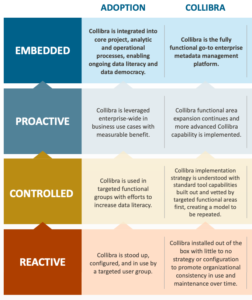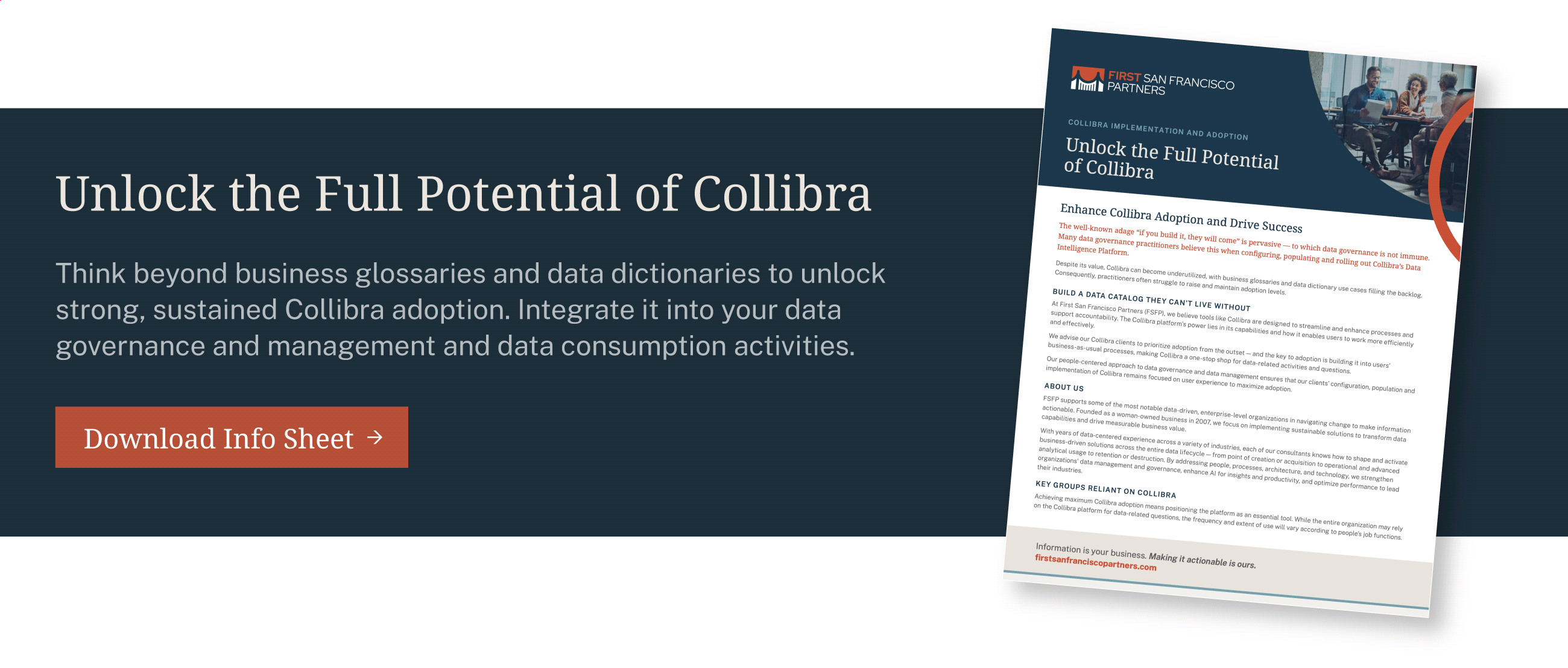If your organization has invested in Collibra to enable data governance and metadata management, you’re one step closer to expediting speed to insight and making data intelligence meaningful.
While the tool itself is powerful, its real value is actualized when people choose to use it to do their work more efficiently and effectively. This choice is adoption — and adoption happens one person at a time. Driving adoption to achieve sustained value requires a concerted change management effort. The value of Collibra is optimized when its use is embedded into people’s daily work, the processes and procedures they use on a daily basis, essentially becoming “business as usual.” This creates a sustainable need as opposed to just knowing it is one of many tools available.
We recommend starting organizational change management as soon as you choose to decide to purchase a new technology. Rather than managing by decree and punishment, you can engage people in the change process. While this process may not require significant financial investment, it does require other resources such as time, attention and support.
What Collibra Adoption Looks Like
The adoption of a new technology happens along a curve, starting with no or limited use and ending with the technology being embedded in critical processes and procedures. As an organization moves along the curve, they become more mature in their use of Collibra.
Adoption usually starts in a more reactive, rather than proactive, manner. With Collibra, this means that the tool is stood up, configured, and a targeted group reacts to this implementation by using it. The next stage is the controlled spread of Collibra, rolling it out to targeted functional groups with efforts to increase data literacy.

As adoption spreads, Collibra is leveraged enterprise-wide in business use cases with measurable benefit. It is proactively used within the established use case. When Collibra is fully adopted, it is integrated into core project, analytic, and operational processes, enabling ongoing data literacy and data democracy.
To the right you’ll see how First San Francisco Partners views the Collibra and Adoption Maturity Journey, which also progresses along the core components of data governance: people, process and technology (not pictured).
Nine Best Practices to Bridge the Gap
To truly capitalize on the potential of technology, you must be prepared to champion change, collaborative adoption and user enablement. FSFP recommends the following nine critical best practices for driving Collibra adoption. These best practices are based on decades of experience implementing sound data governance, data management and fit-for-purpose technology implementations (including Collibra) for clients of all sizes and varying industries.
By using these best practices, you can begin laying a foundation for meaningful, lasting change that drives sustained value from data governance with Collibra:
- Focus on the Value Case (read article)
- Engage the Right People at the Right Time (read article)
- Align Technology Adoption with Change Management (read article)
- Communicate Early and Often (read article)
- Make Training Meaningful and Accessible (read article)
- Measure Impact and Progress (read article)
- Plan For and Manage Resistance
- Integrate (meta)Governance
- Blend Agile and Traditional Approaches to Data Governance
Remember that at the end of the day, people only have so much capacity to make a change. Major technology initiatives, like implementing Collibra, don’t happen in a vacuum. It affects real people in real time in the real world, which is both professional and personal. Change management exists to assess and address the human factors that will impact your Collibra implementation and drive adoption.
It is only through the adoption of a new technology that you will realize its benefits. Using change management will help you to get the most out of your investment in Collibra, while also helping to keep people within the organization engaged and motivated to continuously improve how they work.
We’ll be exploring each best practice in more depth in future posts, so stay tuned for more Collibra adoption-focused learnings coming soon!
View Becky Lyons’ Collibra Best Practices article series.



